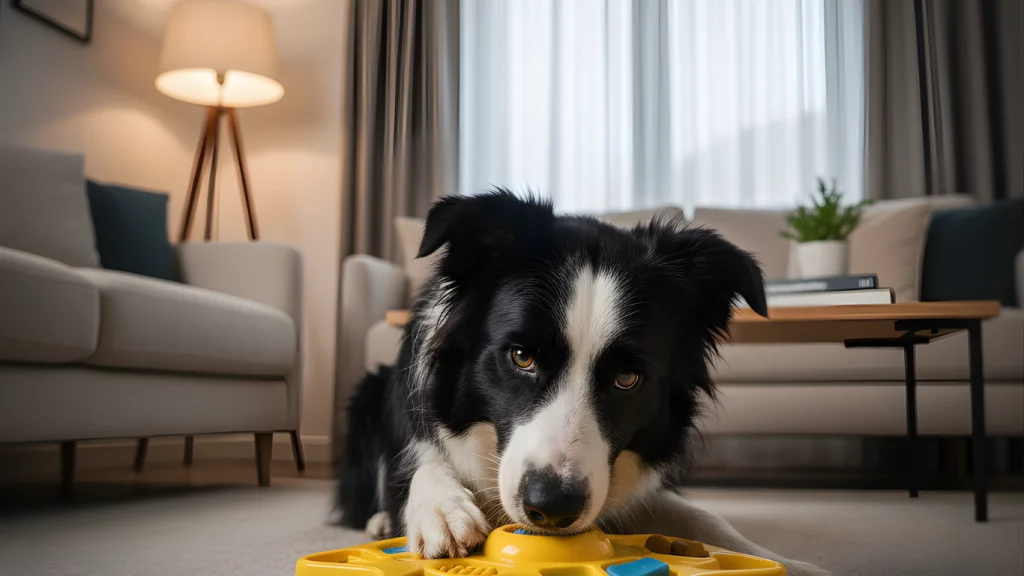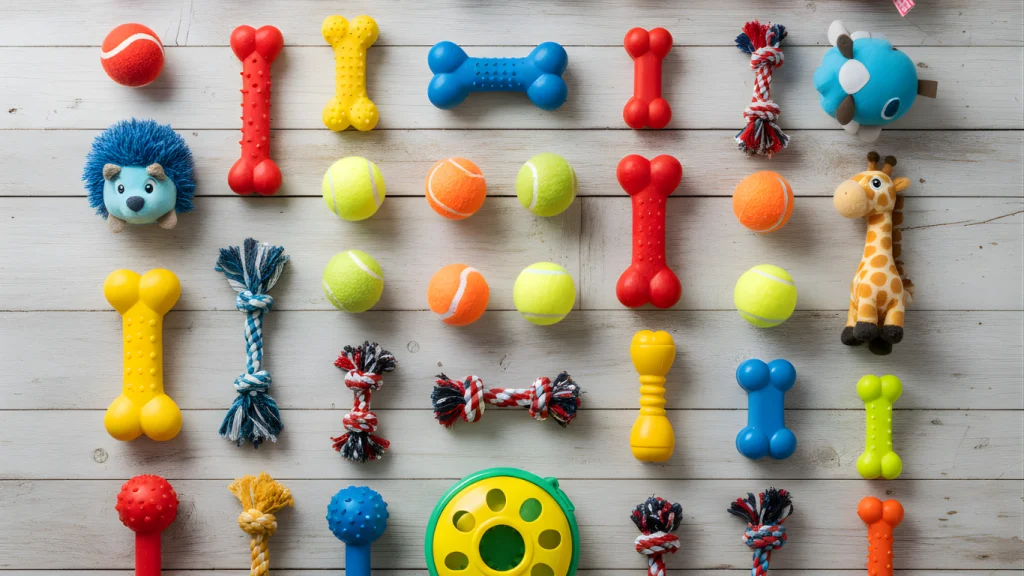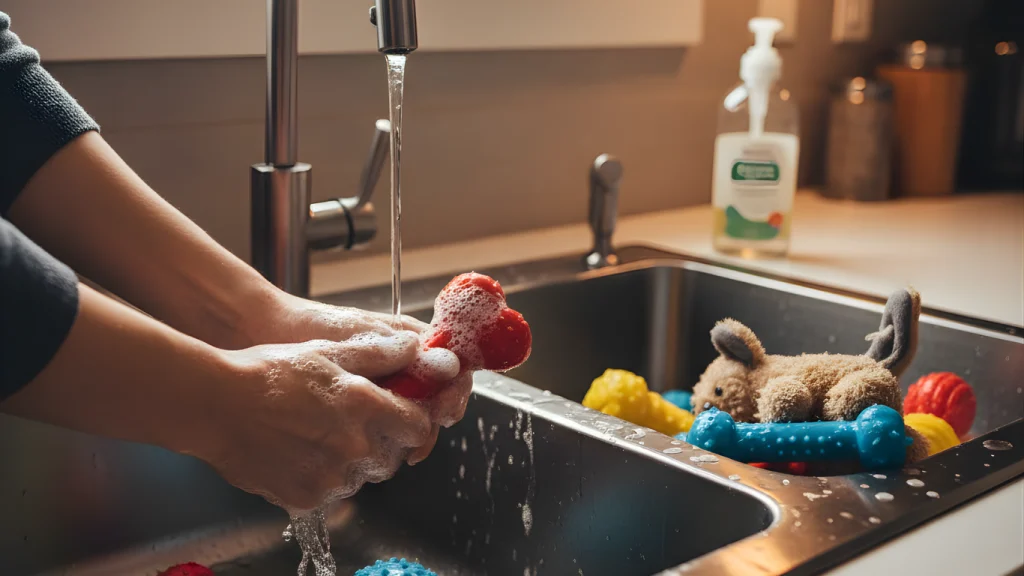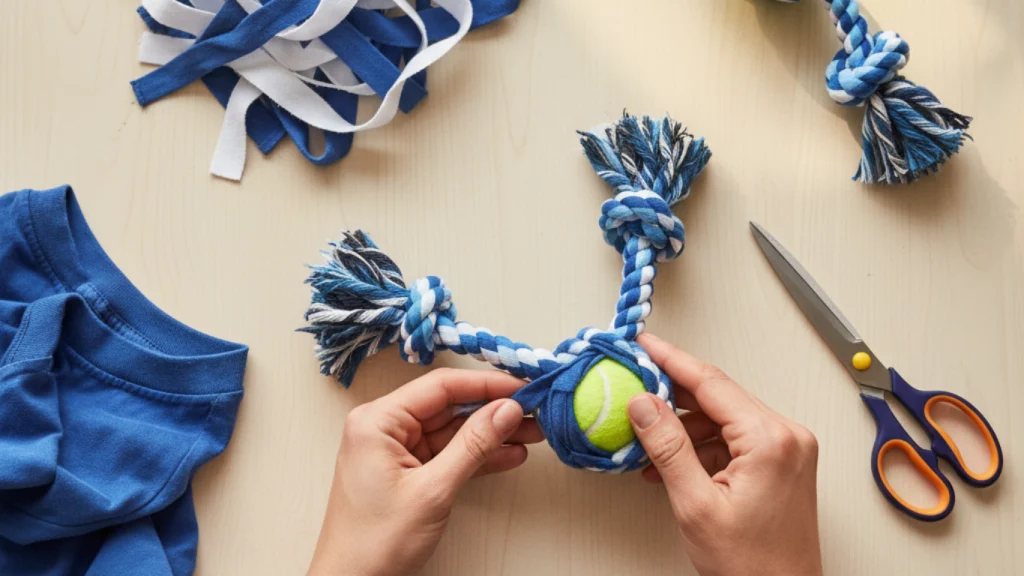As a dog owner, one of the most enjoyable parts of the job is watching my dog play with their toys. But as I’ve learned over time, dog toys are not just about fun – they are essential tools for keeping my dog healthy, mentally stimulated, and physically fit. The right toys can help with everything from cleaning teeth to preventing boredom. Choosing the best dog toys, however, can be a bit tricky with so many options available.
In this comprehensive guide, I’ll take you through everything I’ve learned about dog toys – from the types of toys to pick based on your dog’s needs, to the importance of safety, cleaning, and maintenance. By the end of this guide, you’ll be equipped with all the information needed to ensure that your dog has the best playtime experience.
What You’ll Learn in This Guide:
- Why dog toys are essential for your pup’s health
- The different types of dog toys available
- How to choose the right toy for your dog’s size, age, and breed
- Tips for maintaining and cleaning your dog’s toys
- How to avoid common mistakes when choosing dog toys
- Popular dog toy brands I trust and recommend
- Fun DIY dog toys you can make at home

1. Why Dog Toys Are Important for Your Pup
You might be wondering why dog toys are so important. After all, they’re just for fun, right? Well, I’ve found that dog toys play a crucial role in both my dog’s physical and mental health. Let me break down the reasons why I believe dog toys are essential:
Physical Health
Dog toys help keep my dog active and fit. Whether they’re running around chasing a ball or gnawing on a chew toy, these activities promote exercise and prevent obesity. Regular playtime also helps to build and maintain muscle strength, keeps joints moving, and encourages healthy physical activity.
Mental Stimulation
Mental stimulation is just as important as physical exercise. Toys that challenge my dog’s brain, like puzzle toys and treat-dispensing toys, dog toys prevent boredom and provide cognitive stimulation. This is especially true for intelligent breeds like Border Collies and Poodles, who thrive on mental challenges. A mentally stimulated dog is less likely to engage in destructive behaviors.
Dental Health
I’ve found that dental health is often overlooked in dog care. Chew toys are great for helping my dog maintain clean teeth. Chewing naturally helps scrape plaque and tartar off their teeth, reducing the chances of dental diseases. Some toys are specifically designed for this purpose, such as rubber toys with ridges or nubs, which work wonders for cleaning my dog’s teeth.
Behavioral Benefits
Toys are not only about fun – they also play a significant role in my dog’s behavior. Having the right toys keeps my dog engaged and reduces the chances of boredom. Bored dogs often resort to destructive behaviors, such as chewing on furniture, digging, or excessive barking. A dog that’s well-entertained with appropriate toys is often better-behaved.
2. Types of Dog Toys
When it comes to choosing the right dog toy, there are many types to consider. Here’s a breakdown of the most common dog toys, and how they serve different needs for your dog:
Chew Toys
Chew toys are essential for all dogs, especially those who like to gnaw on things. Whether it’s a puppy teething or an adult dog with strong chewing instincts, chew toys offer a great outlet for this behavior. Plus, they help clean teeth and massage the gums.
- Examples: Rubber bones, nylon chews, rawhide, and antler chews.

Interactive Toys
Interactive toys challenge my dog’s mind, keeping them mentally stimulated. These toys usually involve some problem-solving, such as opening a compartment to release a treat. I often use interactive toys to engage my dog and give them a fun challenge.
- Examples: Puzzle toys, treat-dispensing balls, and snuffle mats.
Fetch Toys
Fetch toys are great for dogs who love to run and play outside. A good fetch toy can provide hours of exercise and fun. Whether it’s a ball, a frisbee, or a flying disc, fetch toys are essential for active play, especially in high-energy dogs.
- Examples: Tennis balls, Chuckit! balls, frisbees, and flying discs.
Plush Toys
Soft, plush toys are comforting for dogs, especially smaller breeds or those who enjoy snuggling. Many dogs also enjoy playing with squeaky plush toys, which mimic the sound of prey and tap into their natural hunting instincts.
- Examples: Stuffed animals, squeaky toys, and plush bone-shaped toys.
Tug Toys
Tug-of-war is a classic game for bonding with your dog, and tug toys are essential for these activities. They encourage physical play and provide both you and your dog a fun way to engage. Tug toys also help with strengthening your dog’s jaw muscles.
- Examples: Rope toys, bungee tug toys, and braided tug ropes.
3. Choosing the Right Dog Toys for Your Pup
When selecting toys, I always take my dog’s size, breed, age, and activity level into consideration. Not every toy is suitable for every dog, so here’s how I go about choosing the right one:
Size and Breed Considerations
Dog toys should always match your dog’s size. For example, small dogs like Chihuahuas or Pomeranians need toys that are sized appropriately for their tiny mouths. On the other hand, large breeds like German Shepherds or Great Danes need more durable, larger toys that can withstand their strength.
- Small Dogs: Soft toys, lightweight rubber toys, and mini chew toys.
- Large Dogs: Larger, heavy-duty toys that are tougher and more durable.
- Aggressive Chewers: For dogs who are heavy chewers, like Pit Bulls or Rottweilers, choose durable, chew-resistant toys made from tough materials like nylon or rubber.
Age Considerations
A puppy has different needs compared to an adult dog or a senior dog. Puppies need toys to help with teething, while older dogs may need more comfort-oriented toys. Interactive toys are great for puppies who need mental stimulation, while older dogs may prefer something softer or easier to chew.
- Puppies: Soft teething toys, chew sticks, and small plush toys.
- Adults: Durable chew toys, interactive puzzle toys, and fetch toys.
- Senior Dogs: Soft plush toys, low-impact toys, and toys that don’t require too much effort to engage with.
Behavioral Considerations
Every dog has their own unique behavior traits. For example, a dog that loves to fetch may thrive with a ball or frisbee, while a dog that enjoys mental challenges may prefer puzzle toys or treat-dispensing toys. By understanding my dog’s personality, I choose toys that keep them entertained and engaged.
4. How to Maintain and Clean Dog Toys
Keeping dog toys clean is essential for maintaining your dog’s health and safety. Here’s what I do to make sure my dog’s toys stay in top condition:

Regular Cleaning
I clean my dog’s toys on a regular basis, especially the ones they use outside. Rubber, nylon, and plastic toys can be easily washed with soap and water, while plush toys can be machine-washed (if they don’t have any small parts that could fall off).
Inspecting for Damage
Every time I give my dog a toy, I inspect it for any signs of wear and tear. Damaged toys can be dangerous, as pieces could break off and become choking hazards. I always replace toys that have been chewed apart or have broken edges.
Disinfecting Toys
When my dog’s toys get extra dirty, I disinfect them. A quick wipe-down with pet-safe disinfectant is often enough to remove germs. For toys that need a deeper clean, I boil them in hot water for a few minutes, especially if they’re made of natural materials like rubber.
5. Common Mistakes to Avoid When Choosing Dog Toys
Over the years, I’ve learned a few things about dog toys – including the common mistakes I made at first. Here are the most common ones:
Choosing the Wrong Size Toy
A toy that’s too small can be a choking hazard for large dogs, while a toy that’s too big can be difficult for small dogs to enjoy. It’s important to choose toys that are sized appropriately for your dog’s breed and size.
Ignoring Safety Features
Not all toys are safe. I always look for toys that are non-toxic and free of harmful chemicals. Some toys, especially cheap ones, can contain substances that can harm my dog. Be sure to look for certification and read the labels carefully.
Not Supervising Playtime
Even though I trust my dog, I always supervise playtime, especially with new or complex toys. Some toys, especially interactive ones, may need some guidance, and it’s always best to keep an eye on your dog, particularly if they tend to get too excited.
6. Popular Dog Toys Brands I Trust
After trying many dog toy brands over the years, I’ve found a few that I trust and recommend. Here are my top picks:
- KONG: Known for their durable rubber toys and interactive treat-dispensing toys, KONG is a brand I always rely on for long-lasting fun.
- Chuckit!: This brand is the go-to for fetch toys. They’re perfect for outdoor play and offer durable, high-quality balls and flying discs.
- Nylabone: When my dog is in the mood for a good chew, I reach for Nylabone. Their chew toys are strong and come in different shapes and sizes.
- West Paw: This brand specializes in eco-friendly, safe, and durable dog toys that are tough enough for aggressive chewers.
- Benebone: Known for their strong chew toys, Benebone is a brand I trust for heavy chewers.
7. Fun DIY Dog Toys You Can Make at Home
If you’re feeling crafty, I’ve found some simple DIY dog toy ideas that don’t require a lot of time or effort. Here are some I’ve tried myself:
T-Shirt Rope Toy
Old t-shirts can easily be turned into a fun rope toy. Just cut the shirt into strips, braid them together, and tie off the ends. It’s a great way to recycle old clothes and make something fun for your dog.
Tennis Ball Puzzle
Take a tennis ball and cut a small slit in it. Then, stuff it with treats to create a fun puzzle for your dog to solve. It’s simple, cheap, and keeps my dog entertained for hours.
Sock and Tennis Ball Toy
This is another easy toy to make. Just put a tennis ball inside a sock and tie the end. It’s a simple, no-sew toy that works well for tug-of-war or fetch.

Conclusion
Choosing the best dog toys for your pup is about more than just entertainment. The right toys promote physical health, mental stimulation, and good behavior. By considering your dog’s size, age, and behavior, you can choose toys that will keep them happy and healthy. With the right maintenance and safety precautions, these toys will provide long-lasting fun for both you and your dog.
FAQ Section
- How do I know if a dog toy is safe for my dog?
Check the size, material, and durability of the toy. Look for non-toxic, BPA-free, and chew-safe certifications. Regularly inspect toys for damage. - Can I make my own dog toys?
Yes, I’ve made several toys from old clothes, tennis balls, and socks. Simple materials can be turned into fun, engaging toys. - What’s the best toy for an aggressive chewer?
Tough toys made from durable rubber or nylon, such as Nylabone or Benebone, are ideal for aggressive chewers.
